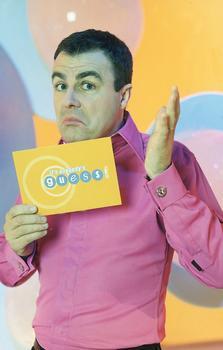It's Anybody's Guess
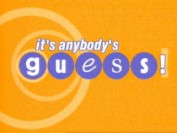
Contents |
Host
Broadcast
Cactus TV for Carlton London (regional), 24 January to 17 March 2000 (40 episodes in 1 series)
Synopsis
Sunshine over the horizon
This review is being written in June 2000. So far this Millennium Year there hasn't been much to write home about, apart from the bad weather, although to be fair the Autumn season approaching looks promising. In the meantime, however, there's It's Anybody's Guess, an afternoon show for the benefit of Carlton viewers only (or so it seemed to us).
Now it's hosted by Paul Ross, devised by Simon Ross, produced by Amanda Ross, and the theme music's sung by Diana Ross (we made that last one up) so you know it's likely to be promising. And - phew - in the main it is.
This show has principles
The principle of the show is pretty straightforward. A difficult estimation question is posed to three "celeb plus punter" pairings. They have to try to get the right answer. As this is extremely unlikely (but not impossible, as we'll explain in a moment) they are given a margin of error - in practice, about 10% of the total range of possibility given. If no-one is close, the closest pair to get to the right answer gets 5 points. If the correct answer falls within the range of any of the teams, they get 10 points instead.
The whole point, keen observers will have noticed, of having teams with pairs in is that you get arguments when they cannot agree on what figure to go for (a sort of Play Your Cards Right dynamic, if you will). This provides most of the entertainment of the show.
The range of questions is varied - sometimes it's to guess a particular year, sometimes its to guess a cost, and sometimes it's even a percentage. With cases such as the latter, where there are only so many numbers to choose from, it's feasible that someone can get it spot on. In this case, that team gets a whopping 15 points, and no mistake.
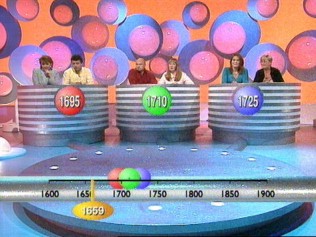 No-one got the right answer, but the red team are closest so they bag 5 points
No-one got the right answer, but the red team are closest so they bag 5 pointsIn each show there tends to be seven questions, a few of which involve vox pop packages (filmed from somewhere in the Carlton region) which are used to form the basis of the question (e.g. "Of the 238 people we asked, what percentage had touched a snake?"). The vox pop package is put together in such a way that the true proportion of "Yes"s and "No"s is not given away.
And now... the science bit
The winning pair go through to the end game, and to be frank it took us a couple of goes to get the idea but once you've got the hang of it you have to agree it's very clever.
There are three types of "ranges" that the team can use to try to identify the winning number. The blue range is the biggest, but it also gives away the smallest prizes. The orange range is half as small, but has better prizes. The pink range is weenier still, but gives away the top booty.
The team can choose which range to go for each time, and Paul tells them whether their range contains the correct answer or not. After three ranges, Paul says what the correct answer is and they win the corresponding prize.
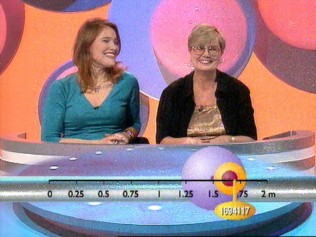 Here the team have managed to get the correct answer in a pink zone, so it's mucho prizes for them
Here the team have managed to get the correct answer in a pink zone, so it's mucho prizes for themWhat do we think?... Go on, guess
So, let's look at the evidence. What we have here is a simple idea well executed. The pace is a little plodding sometimes, not helped by the insertion of the VT packages, but nevertheless this is a extremely well crafted show - particularly for its afternoon timeslot which is traditionally the graveyard of innovation - and we wish it a speedy return to our screens.
Inventor
Devised by Simon Ross.
Web links
Pictures
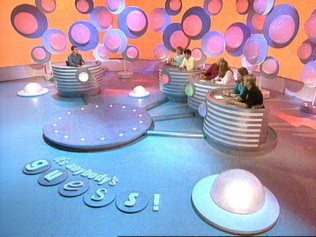 The set
The set
